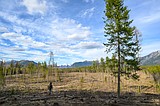Wayward goats
CHRIS PETERSON | Hagadone News Network | UPDATED 5 years, 8 months AGO
Chris Peterson is the editor of the Hungry Horse News. He covers Columbia Falls, the Canyon, Glacier National Park and the Bob Marshall Wilderness. All told, about 4 million acres of the best parts of the planet. He can be reached at editor@hungryhorsenews.com or 406-892-2151. | November 20, 2019 7:36 AM
Some Glacier National Park goats are homebodies, but others travel quite a distance, a new study has found. Glacier currently has 10 mountain goat nannies that are wearing GPS - enabled collars as part of a multi-year parkwide study of goats that started in 2018.
To date, Glacier has goats with collars in four distinct population areas — Logan Pass, Lake Ellen Wilson, Sperry Chalet and the Goat Lick, at the south end of the Park near Highway 2. The Logan Pass goats do travel to Many Glacier to natural mineral licks in the spring months. That’s a journey of roughly seven miles or so one-way, noted Park supervisory biologist Mark Biel, who is heading up the study.
The Park knew those goats traveled to Many Glacier from a previous study that examined goat dynamics at Logan Pass.
But the Goat Lick goats were the real travelers. They went from the slopes of Running Rabbit Mountain in late August to the summit of Great Northern Mountain above the Hungry Horse Reservoir in about a day.
That’s a journey of about 14.7 miles, which includes swimming the Middle Fork of the Flathead and a trek through the forest.
Why the goats made the journey isn’t clear, Biel noted. Late August isn’t the breeding season and goats generally migrate to mineral licks in the spring. In addition, the banks of the Middle Fork of the Flathead are already a mineral lick. So why they went that far isn’t clear.
The goats stayed about three weeks on the massive Great Northern Mountain and then returned to the Park. A goat that travels to Great Northern in susceptible to hunting, albeit limited in scope. Great Northern is in goat district 140, which allows for just one goat, either sex, to be harvested via special permit drawing.
Biel said they hope to ground-truth the wandering Goat Lick goats next summer to see why they might be traveling to Great Northern.
Mortality is not uncommon in goat populations. The Park initially had 12 goats collared for the study, but two died last year inside the Park. Biologists aren’t sure how they died. By the time they found the collar, which gives off a signal if an animal perishes, there was nothing left but bones and hair and the collar. They could have died by predators or an avalanche.
Grizzly bears and mountain lions are known predators of goats, particularly kids.
While the goats at the Lick were travelers, others were very much homebodies. A nanny collared at Ellen Wilson pretty much stayed in that area of the lake and surrounding peaks. Goats collared at Sperry did the same thing.
Biel said they expected the two populations would intermingle. But that’s not the case so far. Sperry goats stayed to the east and Ellen Wilson goats didn’t hardly cross Lincoln Pass.
The goats pretty much keep to themselves, even though they live a mile or so apart, if that.
The Park hopes to eventually collar up to 20 goats and expand the study to more regions of the Park, Biel noted. They’re also looking at the vegetation goats are targeting and the temperature regimes they prefer. By using remote temperature sensors, biologists can overlay the temperature data onto the goat movement data. They study is also looking at survival of the kids.
The overall idea is to see how climate change is impacting the population and in the end, the Park will look to devise a strategy for conservation of one its most iconic species.
The Park currently about 1,800 to 1,900 goats, studies estimate.
According to Montana Fish, Wildlife and Parks, outside of the Park, the western portion of the state supports native populations that a recent analysis finds have declined over the past 70 years. Those native goats are 3–4 times fewer today than the 4,100 estimated from the first surveys during the 1940s.
Licenses to hunt native goats have been reduced more than 10-fold over the past five decades, FWP notes. East of the Continental Divide, additional populations were established by translocating goats into prehistorically unoccupied habitat. The majority of introduced populations are prospering, with some notable exceptions.
As a result of declines in populations, 12 of Montana’s 52 hunting districts (nine with native populations) have been closed to hunting in recent years, according to a 2017 report.
The goat research in Glacier is supported in part through a grant from the Glacier National Park Conservancy.
MORE FRONT-PAGE-SLIDER STORIES

In Glacier Park, snowfields help mountain goats breathe easy
Hungry Horse News | Updated 4 years, 6 months ago
ARTICLES BY CHRIS PETERSON

Expect more timber harvest on Flathead
Hungry Horse-Glacier View District Ranger Rob Davies said to expect the Forest Service to focus on timber sales in the coming years, as there’s a nationwide directive to increase harvest by 25%.

Ivan O’Neil, founder of WBC, consummate hiker, dies at 96
Noted Flathead Valley businessman Ivan O’Neil, who founded Western Building Centers, died July 15. He was 96.

North Fork Road partially treated for dust
The North Fork Road will have a bit of a split personality this summer.



